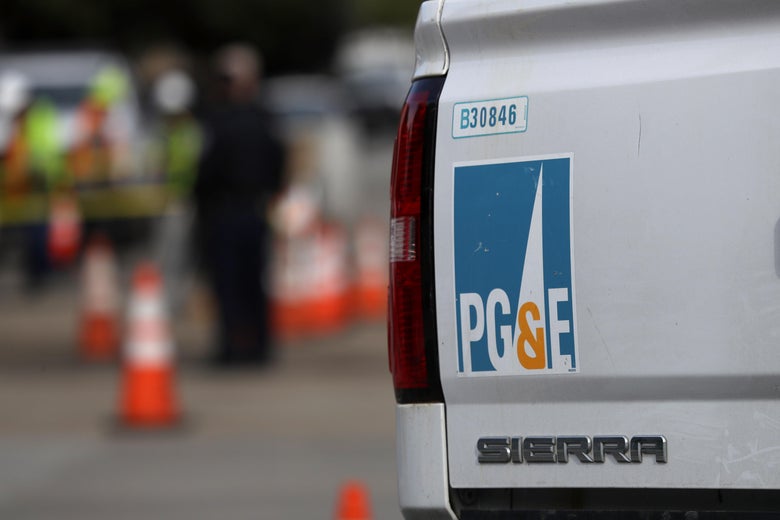What Are Californians Supposed to Do?
PG&E is turning off the power to protect against another fire. It’s created a new kind of disaster.

The news started trickling in Monday afternoon. Pacific Gas and Electric, the largest utility company in the country, was monitoring the wind in California. If the speeds picked up enough, the utility was considering shutting off power to about 30 counties in the state. It wasn’t clear where, exactly, the shut-offs would be. It wasn’t even clear if they would really happen—was this some kind of vague warning? How can anyone trust PG&E, anyway? By Tuesday afternoon, the company’s website wouldn’t even load for many users who were desperately trying to access information.
Californians have a toxic relationship with PG&E. The company was found responsible for 17 of the 21 major fires that blazed across California in 2017 alone. It was responsible for the deadliest fire in California history last year, the Camp Fire, where 86 people were found dead and more than 50,000 were displaced. And then it declared bankruptcy to avoid dealing with the tremendous liability its negligence has caused. On top of all that, PG&E still sends us all bills every month, bills we have to pay or else go without power.
Shutting off the power is PG&E’s attempt to avert disaster. Dry winds are expected to pick up throughout Wednesday and Thursday and barrel through central and Northern California. There hasn’t been sustained rainfall here in months. If the power is left on, a branch of a pine tree could break off and drift into active lines. The dry shrubbery could pile up and spark. A fire could start. More people could die. More homes could burn. The company is making a choice between another climate disaster or shutting down infrastructure. The problem is that grinding a massive swath of the country to a near halt is its own kind of disaster.
By Tuesday evening, local newspapers were reporting that PG&E was going to shut off power for an area with about 2.4 million people by the next morning. Those include residents on dialysis and home oxygen and who use electric wheelchairs. It also includes families and individuals who live paycheck to paycheck and can barely afford the groceries currently in their fridge, which will likely spoil. University classes are canceled. Schools are being closed; 100,000 kids are staying home across the region. Parents will have to find child care or bring their kids to work.
For most us, there was no notice.
Maybe you didn’t hear about what was happening until after you got off work and had already gone home. Maybe you didn’t look at the news in time. Maybe you only found out when your lights wouldn’t turn on Wednesday morning. By then, store parking lots were filled with people stuffing ice into their trunks. Batteries in drugstore aisles were flying off the shelves. Hardware stores were running out of flashlights. Lines at gas stations stretched for blocks. The lights were out inside the rainbow-arched Robin Williams Tunnel that connects Marin County to the Golden Gate Bridge.
PG&E has also set up resource centers in parking lots across the state where residents can use the bathroom and charge their phones. The cities and towns being blacked out are telling residents in need of medical assistance to evacuate. Where are they supposed to go?
The outages could last days. That’s because turning the electricity back on is no small task—every mile of power line that’s been shut off needs to be inspected visually, by foot or vehicle or air. The winds that caused the shutdown could have knocked branches and shrubs into the lines, which will have to be cleared. Power lines run through dense forests only accessible by hiking in. The work can’t be done in the dark.
It’s true that the lights can go off at any time due to a storm. This happens to all of us at some point in our lives. But this feels different. It usually happens because of a natural disaster, like a snow or thunderstorm. This is primarily an unnatural disaster, a disaster of neglected maintenance of power lines owned by PG&E. It feels like the company doesn’t want to be blamed for another tragedy, so it’s just shutting the whole thing down. It also feels like the company doesn’t realize that real people are trying to live here—that this is not a solution, but another version of the problem.
Needless to say, Californians are exasperated. And it feels like there’s not much to be done. There’s no clear way to protest. It’s most people’s only option for power, so boycotts are out of the question. Most people I’ve spoken to want PG&E to be smaller and want accountability. They also want solar power and microgrids, and for the flammable electric lines running through the woods to go away. The most wildfire-prone areas probably need to get off the grid. Of course, none of this is cheap or easy.
Californians are still trying to figure out how to rebuild and help victims of fires that burned months and years ago. No one is sure which path forward will safely provide electricity to the millions of Californians who need it. There isn’t a clear thing to advocate for—it’s not like making PG&E a public or state-run utility would guarantee that residents will be protected. Michigan’s water utility is state-run, after all.
What we do need is for our federal, state, and local politicians to feel immense pressure now to realize this problem is only going to keep getting worse, unless they do something. We can’t keep hopping from crisis to crisis like this. We need to realize that we are living in climate change, and this is the cost. But my fear is that once the lights go back on, things will go back to normal until the next disaster strikes again.







Follow Us!